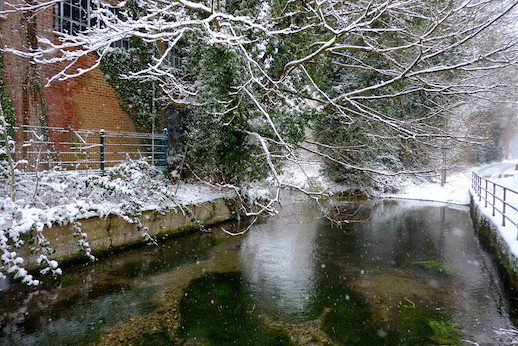Shadows and Reflections: the annual collection of postings where Caught by the River’s ever-reliable contributors and friends old and new take a look back on the events that have shaped the past twelve months. Today it’s the turn of Charles Rangeley-Wilson:
 The ford by the old sawmill on the River Wye. Photo by Charles
The ford by the old sawmill on the River Wye. Photo by Charles
For me 2014 was all about reviving rivers. In that sense it was a year during which shadows lightened.
Almost exactly as 2013 became 2014 I received a letter from one of the chief planners in High Wycombe Council, who had read my book Silt Road. (If you’re reading this but haven’t read my book, it was the story of a river buried under the streets of a town). He had enjoyed the histories I’d described, he wrote. However, the lost river would probably always remain lost because of how much had been built on top of it and how deep it lay under the streets.
Of course, these were the two reasons against unearthing the river that I had read again and again whilst researching the book. This letter gave me a chance to dispute them. I wrote back saying thanks for the kind words. I described how the meandering histories in Silt Road were aimed at understanding why the river had been buried and therefore how it could be re-discovered. The river was so deep under the streets, I said, because it is not the natural river that is buried, but the course of the man-made mill-leats that the river had been corralled inside after centuries of industry and urban development. If it had been diverted before to create these leats, surely it could be diverted again, into whatever route would work so that the river could have daylight above it, not buildings? So that river could breathe again?
I didn’t hold out much hope that my letter would change anything, but a few months later I got a reply from the planner, who said that he had commissioned a study into what I suggested and been told it would work. It might take a long time and the river would have to be uncovered in sections on the back of other developments, but he saw no reason why they couldn’t start planning right away.
It might be difficult to imagine that a letter from a town council planning officer might give me more joy than more or less anything else I could imagine. But this was the best news I could ever have hoped for as a result of writing my book and far eclipsed the brief thrill of a Wainwright Prize long-listing, the vain disappointments of no others. If what I had written could help uncover a lost river then words can make the right kind of difference to a natural world that is besieged on all sides.
The rest of my year was filled with rivers in a different county – Norfolk. All river revival projects too. A once-in-a-lifetime fund of government money, established by a once-in-a-lifetime Environment Minister (thank you Richard Benyon … I’m guessing Cameron moved you on because you actually gave a shit) had reached its termination point, putting me at the coal-face of supervising the “re-wilding” of about 5 km of Norfolk’s loveliest chalk-stream, the River Nar.
To try to explain simply what can get ridiculously complicated: we were restoring natural shape to a river that had been canalised and widened and dredged and otherwise abused. By dropping hundreds of trees into the stream (riverside alders which will sprout and re-grow) we were able to replicate and stimulate natural self-healing processes, but fast forwarded by a few centuries. Of course there’s felling trees and there’s felling trees. The desired effect is aided greatly by a very careful choreography of chaos, which is a lot harder to pull off than it would appear. But I worked with Simon Cain the best in the business of tree-felling-in-rivers choreography. Quite good in the business of chaos too … but that’s another story. Simon is a river artist. I was privileged to be his director.
Upstream there were other versions of the same thing: the discovery and revival of a pre-historic series of meanders, the excavation of 1.5 km of replicated natural meanders in the headwaters of the river etc. You get the picture. It was a long summer. I tore my waders. I didn’t go fishing. If you’re interested in the techy stuff, read my blog.
In between all that I wrote more words for a new book, but not nearly enough of them. This book has nothing whatsoever to do with rivers, excepting that it is all about the ripples and currents of history, the long reach of grief. And now I must get back to that neglected, shadowed task.